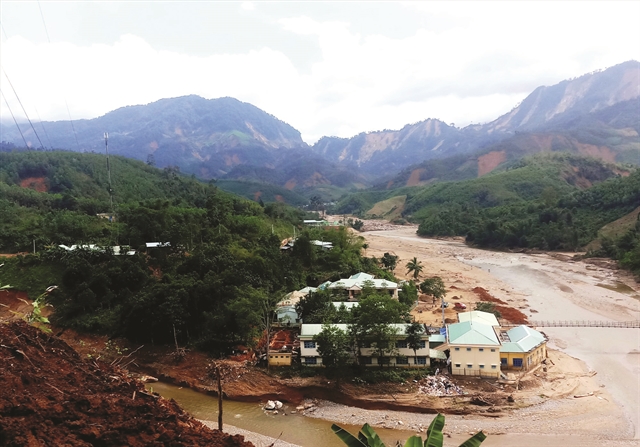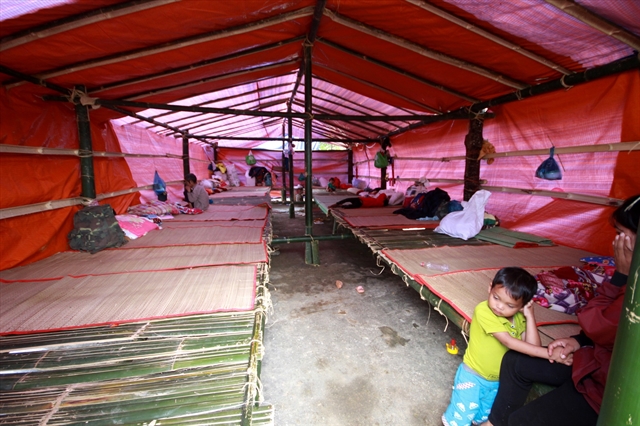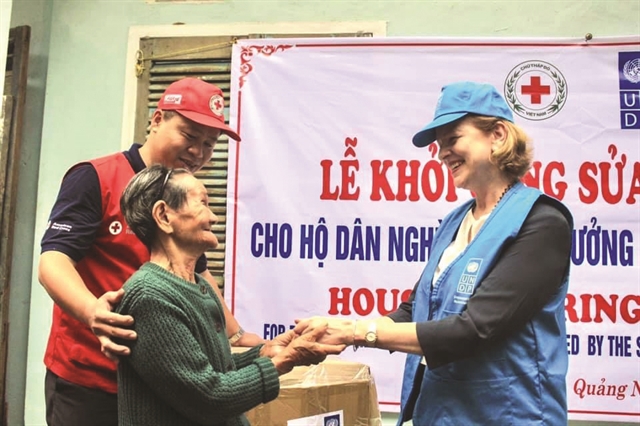 Features
Features

Four storms, including typhoons Molave and Goni, triggered floods and landslides that devastated central provinces in Việt Nam from October to December, with 249 people either killed or missing and 11,700 houses damaged or destroyed. People in hard-hit mountainous areas have been recovering from the historic floods and landslides to ready themselves for a new year of hope, with plentiful support coming from local and central governments.
Four storms, including typhoons Molave and Goni, triggered floods and landslides that devastated central provinces in Việt Nam from October to December, with 249 people either killed or missing and 11,700 houses damaged or destroyed. People in hard-hit mountainous areas have been recovering from the historic floods and landslides to ready themselves for a new year of hope, with plentiful support coming from local and central governments.

|
| HAVOC WROUGHT: Some buildings still stand in central Quảng Nam Province but so many have been damaged, some beyond repair. Photo courtesy of Quảng Nam Newspaper |
By Hoài Nam
Hồ Văn Dương from Tăk Pát Village in Nam Trà My District, Quảng Nam Province, has been building a temporary shelter on a plot of land not his own, after his house and all his property were swept away during the recent flooding and landslides that struck Việt Nam’s central region.
Dương and the eight members of his three-generation family were evacuated when the area was hit by tropical storms Molave and Goni and then landslides.
He and his family have been waiting for a new land allocation and support from local authorities to build a new house, as his village by the Xoan River is now no more.
Quảng Nam Province has reserved total funds of VNĐ3.8 billion (US$165,000) to help 40 families in Nam Trà My District resettle into new houses, and also provided 156 tonnes of rice.
The funds are expected to help households recover after the historic floods in anticipation of the coming Lunar New Year festival which falls in mid-February next year.
“We were concerned about having to flee when the ground nearby started to erode,” Dương said. “My family had little hope and empty hands while heavy rains poured down and landslides ruined the area. But we are now able to build a new house on a plot of land safe from landslides, with assistance from local authorities.”
The district of Nam Trà My has been clearing areas in Trà Leng and Trà Dơn communes to resettle the shaken villagers of Tăk Pát prior to Tết, according to the district people’s committee.
Hồ Văn Man said his house in Trà Văn Village in mountainous Phước Sơn District was completely destroyed by erosion last month; one of 26 dwellings to suffer a similar fate.
He and his family had to evacuate to houses of relatives or to communal houses, while food and other relief aid was provided by the community.

|
| LIFE IN LIMBO: Temporary shelters house people in flooded areas of central Việt Nam while they wait to return home, if their home is still there. Photo courtesy of Quảng Nam Newspaper |
“I felt hopeless, with nothing to my name after our house was buried,” he said. “We only had the clothes we were wearing, while our paddy fields were devastated by the storms. But much-welcome aid came from the community and our neighbours, whose houses were not damaged.”
“Local authorities and people brought food and other supplies to help us in our hour of need. We have now been seeking support and funds to build a new house and resettle our lives.”
Businesses and local authorities have helped build 15 houses on community land for the most impoverished families, while temporary housing has been built for those not in such dire straits.
Children in Trà Văn Village have returned to school, while sufficient food and supplies will allow villagers to get by for several months before they can return to farming.
Temporary shelters were built in Phước Thành Commune, after 100 families had to stay at health centres or in communal administration buildings.
Hồ Văn Lưng from Phước Lộc Commune said one building of the communal administration has become home to 50 families since the floods and landslides.
Hồ Văn Đề and the remainder of his family, meanwhile, found shelter at a school in Trà Leng Commune, after his house and the housing of other families were lost in the floods.
Unfortunately Đề lost eight family members from the terrible landslides in November, while only three corpses were found.
“We now have nothing to lose,” he said. “Everything has gone. All the villagers can hope for is good weather while rebuilding the village. Life must go on.”
Recovery efforts have also been revved up in A Xan Commune in Tây Giang District, with dozens of houses being rebuilt.

|
| SUPPORT COMES: Caitlin Wiesen (right), UNDP Resident Representative in Việt Nam, hands over emergency aid to a family in central Việt Nam. Photo courtesy of UNDP |
In neighbouring Thừa Thiên-Huế Province, 100 households and 100 poor students in mountainous A Lưới District have received assistance from the local border guard force.
Despite the heavy rains, search and rescue teams went out in search of victims of landslides at the Rào Trăng 3 Hydropower Plant and were, in turn, lost in landslides themselves.
A total of VNĐ80 billion (US$3.5 million) was also raised from organisations and individual donors to support flood and storm-affected areas in Quảng Trị Province.
The Việt Nam Insurance Corporation also reserved 2,500 health insurance cards for local people in flood-hit areas in 10 central provinces.
The Việt Nam Motherland Front provided VNĐ40 million for each house repair in the central region, from total funding of VNĐ350 billion (US$15.2 million).
The Government previously allocated emergency funds of VNĐ580 billion ($25.2 million) and 15,500 tonnes of rice to people in flood-stricken provinces.
The UK Government, meanwhile, announced it was donating 500,000 GB pounds (US$650,500) in support.
The United Nations Population Fund (UNFPA) in Việt Nam made available US$540,000 to secure immediate support for women and girls in six provinces; while the United Nations Development Programme (UNDP) supplied part of its emergency assistance of US$400,000 to affected people and repaired 300 houses in the five hardest-hit provinces of Quảng Bình, Quảng Trị, Thừa Thiên-Huế, Quảng Nam, and Quảng Ngãi.
The UNDP expects to leverage another $1 million for emergency response and recovery efforts.
Hồ Văn Lừng in Phước Lộc Village, Quảng Nam, which was devastated by landslides, said houses need to be rebuilt first, as people want to feel safe with a roof over their heads before they return to farming.
Local authorities have been calling for joint efforts by businesses, communities, individual donors, and organisations in resettling people in new houses so they may celebrate Tết (Lunar New Year festival) and look forward to a better new year. – VNS




